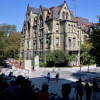The hidden costs of being a university student

The average university student will probably decide to not buy every single coursebook in their reading list. After all, universities often provide soft copies and have open libraries for all these books that students can benefit from without spending a penny. Then again, the hidden costs of studying in university go a lot further than just the books themselves. Sometimes, these costs aggregate to a significantly high amount throughout a student's academic journey. One may not always feel the need to watch these costs but it should serve as a good measure to know exactly how to avoid splurging more than necessary.
In nearly every university, Architecture students usually pay the highest tuition fees in addition to clocking in the greatest number of course hours. Anybody studying this major will be able to tell you that buying materials for models and projects is a serious business and requires the same diligence as purchasing groceries. One has to find good quality materials and that too at a reasonable price. Although most of these products do not cost an arm and leg, once these add up over weeks and months, one soon realises that they are running a long bill for the crafty work. Engineering students of other disciplines will often face a similar problem in regards to buying things like lab equipment. While most of the required materials will be available on campus stores, there will almost certainly be a less expensive alternative for it off-campus.
Sometimes costs can show up in the form of presentations and interviews. Business students go through gruelling presentations nearly every semester. Presentations are strictly formal and everyone is required to be dressed formally for several days. Most times, ready-made suits and blazers just don't cut it and students are better off having a suit custom-made for themselves, which can cost around BDT 7,000. This is where creativity can go a long way. Getting suits and shirts in neutral colors that can be mixed and matched will have one covered for several of their presentations.
Of course, certain majors are a little less about attires and stationery and more about travel costs or buying a long list of additional reading materials. English majors or Humanities majors will often find themselves in such positions where this list will comprise of some very high-end books. Environmental Sciences majors who travel a lot for course-based field trips need to carefully budget their frequent trips for a better experience.
After a few semesters, most students will have a solid understanding of these nitty-gritty things that contribute to unexpected added cost and budgeting will get easier. No one gets it done in the most efficient way possible right away and there is certainly a learning curve, but making a budget can prevent overspending on products and materials that are required on a regular basis. It is also very useful to consider online shopping as many things cost more when bought from physical stores. Online stores may not always provide premium quality but it is still an economically viable option given many of the purchases will not be used for more than one or two semesters.
It becomes rather important that one can step back to take a look at the entire cost of devoting four-five years in this program before making the big leap. The hidden costs should not be a make-or-break factor in determining whether to commit to a certain program but making note of them will encourage more people to find better roundabouts to incurring such costs.
Irina Jahan is a student at North South University.

 For all latest news, follow The Daily Star's Google News channel.
For all latest news, follow The Daily Star's Google News channel. 









Comments